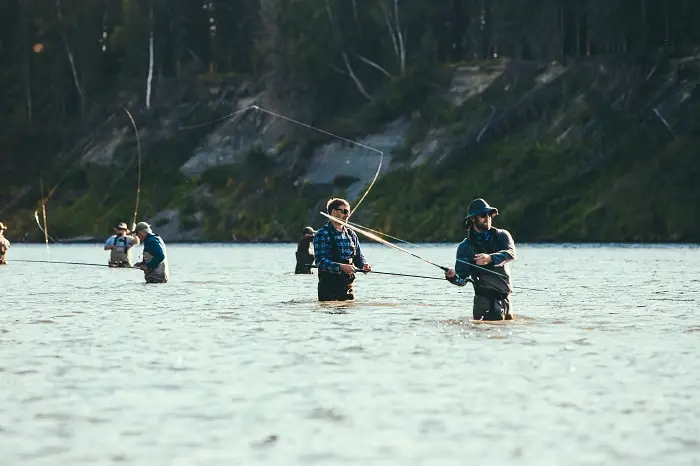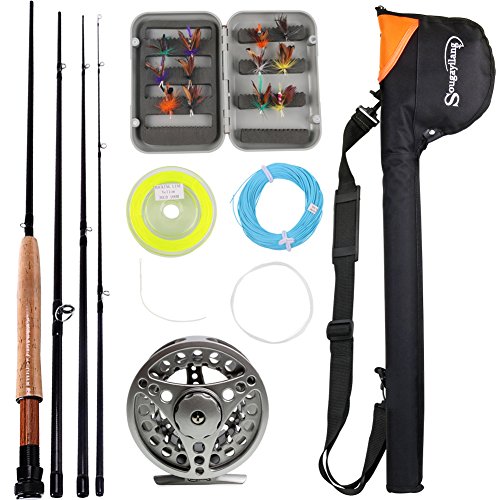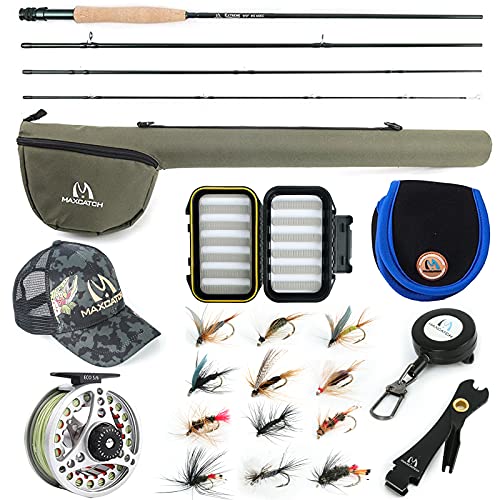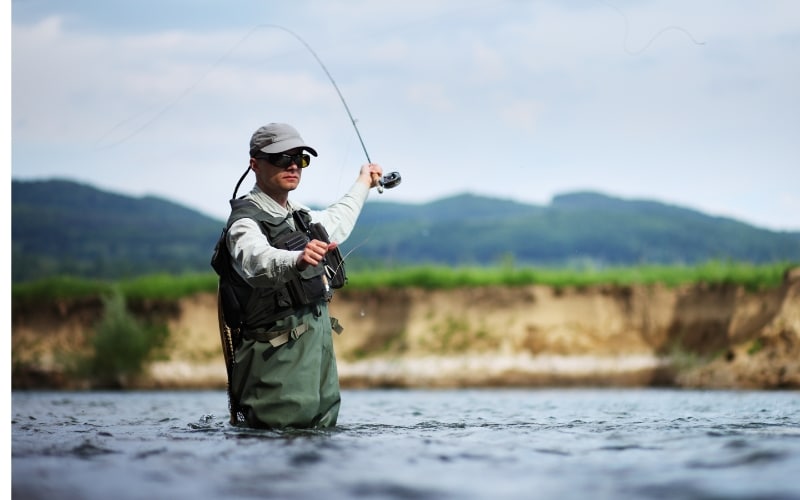Saltwater fly fishing is an exciting and challenging sport that allows anglers to test their skills in the vast and dynamic environment of the ocean. Whether you are a beginner or an experienced angler, fly fishing saltwater offers endless opportunities to explore and connect with nature.
Unlike freshwater fly fishing, saltwater fly fishing requires a different set of techniques and equipment due to the powerful and unpredictable nature of saltwater species. From bonefish to tarpon, permitted to snook, various species await to be chased in the saltwater.
For beginners, fly fishing saltwater may seem daunting, but with the proper knowledge and practice, anyone can excel in this adrenaline-pumping activity.
This article will guide you through the basics of saltwater fly fishing, including the necessary gear, casting techniques, and target species. So grab your fly rod, tie some flies, and get ready to embark on an unforgettable journey into the world of saltwater fly fishing.
Quick Jump
ToggleGetting Started In Saltwater Fly Fishing
Saltwater fly fishing is a challenging and gratifying hobby for anglers of all skill levels. It is a great way to target a variety of saltwater species, including redfish, snook, tarpon, bonefish, and more.
If you are a new saltwater angler, there are a few things you need to get started. Once you have your gear from your nearby local tackle shop, you need to learn how to cast.
Saltwater fly casting is similar to freshwater fly casting, but there are a few key differences. One difference is that you need to use a double haul to cast longer distances. Another difference is that you need to be able to cast in the wind.

There are many resources available to help you learn how to cast a saltwater fly rod. You can find books, articles, and instructional videos online. You can also take a fly casting lesson from a qualified instructor.
Once you have learned how to cast, you are ready to start fishing. The best place to start is in a shallow bay or estuary. This is where you will find many of the most popular saltwater fly-fishing fish, such as redfish and snook.
When it comes to New England saltwater fly anglers, essential flies such as the chartreuse-and-olive Clouser Minnow are indispensable, suitable for targeting fish in shallow flats and depths of up to 60 feet.”
Saltwater Fly Fishing Gear
Saltwater fly fishing requires specialized gear designed to withstand the harsh conditions and strong fish found in saltwater environments. Here’s a list of essential gear for saltwater fly fishing tackle that you can get from any fly shop:
- Fly rod: Saltwater fly rods are typically made of high-modulus carbon fiber and are designed to be durable and powerful. Rod weights range from 7 to 16, with heavier rods being used for bigger fish.
- Fly reel: Saltwater fly reels need to be able to handle the weight of heavy fly lines and the drag needed to land large fish. Reels are typically made of aluminum or stainless steel and have large arbors to accommodate the thick fly lines used in saltwater.
- Fly line: Saltwater fly lines are made of polyurethane or fluorocarbon and are designed to float in saltwater. They come in a variety of weights and tapers, depending on the type of fish being targeted and the conditions.
- Tippet: Tippet is the thin line that connects the fly line to the fly. It is typically made of fluorocarbon or nylon and is available in a variety of weights.
- Fly box: Fly boxes are used to store flies. They come in a variety of sizes and styles, but all should be waterproof or have a watertight lid.
- Waders: Waders are used to keep anglers from getting wet when wading in saltwater. They are typically made of breathable materials and come in a variety of heights.
- Boots: Wading boots are designed to provide traction and protection on slippery surfaces. They are typically made of neoprene or rubber and have cleats on the soles.
- Sun protection: Saltwater fly fishing can be very sunny, so it is essential to wear sun protection, such as a hat, sunglasses, and sunscreen.
- Other gear: Other gear that may be helpful for saltwater fly-fishing includes a polarized fishing lens, a landing net, and a fish stringer.
| # | Preview | Product | Rating | Price | |
|---|---|---|---|---|---|
| 1 |

|
Maxcatch Predator Saltwater Fly Fishing Rod: 9ft, 4-Piece, 8/9/10/12... | No ratings yet | $199.99 | Check on Amazon |
| 2 |

|
PENN Fishing Battle Fly Reel and Fishing Rod Outfit Combo, Black, 10wt... | No ratings yet | $179.99 | Check on Amazon |
| 3 |

|
Redington Tropical Saltwater Fly Fishing Field Kit, 9' Medium-Fast... | No ratings yet | $379.94 | Check on Amazon |
| 4 |

|
Sougayilang Saltwater Freshwater Fly Fishing Rod with Reel Combo Kit... | No ratings yet | $79.98 | Check on Amazon |
| 5 |

|
5 wt. 9'0" 4 pc. NXT Black Label Kit | No ratings yet | $229.95 | Check on Amazon |
| 6 |

|
Sougayilang Fly Fishing Rod Reel Combos with Lightweight Portable Fly... | No ratings yet | $87.65 | Check on Amazon |
| 7 |

|
M MAXIMUMCATCH Maxcatch Extreme Fly Fishing Combo Kit 3/5/6/8 Weight,... | No ratings yet | $79.99 | Check on Amazon |
Additionally, here are some specific items that are popular for any saltwater fly fisherman:
- Saltwater fly patterns: There are a variety of fly patterns that are specifically designed for saltwater fishing. Some popular patterns include Clouser Minnows, Deceivers, and Wooly Buggers.
- Saltwater fly fishing accessories: Some accessories can be helpful for saltwater fly fishing, such as bite alarms, shock leaders, and leader clippers.
With the right gear, you can be well on your way to enjoying successful saltwater fly fishing expeditions.
How Do I Choose a Saltwater Fly Rod?
Choosing a saltwater fly rod requires careful consideration of various factors. First and foremost, the rod’s performance in windy conditions should be a top priority. Saltwater locations often experience strong gusts, so it’s crucial to select a rod with fast action and a high line speed to cast successfully.
Additionally, the rod’s power and versatility are essential. A saltwater fly rod should be able to handle larger fish species and present flies effectively in different environments. Another important aspect is the material and construction of the rod.
Opting for a rod with corrosion-resistant components, such as stainless steel or titanium guides, will ensure its durability in saltwater conditions. Lastly, considering your budget and personal preferences will aid in finding the perfect saltwater fly rod that suits your needs.
How Do I Choose a Saltwater Reel?
Choosing a saltwater reel requires considering several factors. First, decide on the type of reel you want, whether it’s a spinning reel or a conventional reel. Spinning reels are generally easier to use, especially for beginner saltwater fly anglers, while conventional reels provide more power and control.
Next, consider the reel’s size, as it should match the rod you’ll be using. Smaller reels are suitable for lighter tackle, while larger reels are better for heavier tackle.
Also, pay attention to the gear ratio, which determines how quickly the line is retrieved. For saltwater fishing, a high gear ratio is recommended for faster line retrieval.
Lastly, check for a reel with a corrosion-resistant body and materials, as salt water can cause damage. Overall, a thorough consideration of these factors will help you select the right saltwater reel for your fishing needs.
What Fly Line Do I Use for Saltwater Fly Fishing?
The best fly line for saltwater fly fishing depends on the specific fish species you’re targeting, the water conditions, and your casting style. However, there are some general guidelines you can follow when choosing a fly line.
Saltwater fly lines are typically heavier than freshwater fly lines. This is because they need to be able to cast larger flies, punch through wind and currents, and sink deep enough to reach fish that are feeding below the surface.
Saltwater fly lines also need to be durable. Saltwater is corrosive, and it can quickly degrade a flyline that is not designed for it.
Here are some specific fly line recommendations for different saltwater fishing situations:
- Floating line: Floating line is used for fishing in calm water or sight casting to fish on the surface. It is also a good choice for fishing with topwater flies, such as poppers and gurglers.
- Intermediate line: Intermediate line is an excellent all-around fly line for saltwater fishing. It sinks slowly, allowing you to fish below the surface without having to add a lot of weight to your fly.
- Sinking line: Sinking line is used for fishing in deeper water or targeting fish feeding below the surface. Sinking fly lines come in different sink rates so that you can choose the right line for specific conditions.
- Tropical fly line: Tropical fly lines are designed for fishing in warm climates. They are typically more supple than other types of fly lines, making them easier to cast in hot weather.
Here are some additional tips for choosing a saltwater fly line:
- Consider the fish you’re targeting. Some fish, such as tarpon and bonefish, require a delicate presentation. You’ll want to choose a lightweight fly line with a long taper for these fish. Other fish, such as striped bass and tuna, are more aggressive and can handle heavier flies and fly lines.
- Consider the water conditions. If you’re fishing in windy or choppy water, you’ll need a heavier flyline that can cut through the wind and currents. If you’re fishing in calm water, you can use a lighter fly line.
- Consider your casting style. If you’re a beginner caster, you’ll want to choose a heavier fly line that is easier to load and cast. If you’re an experienced caster, you can use a lighter fly line that will give you more control.
Once you’ve chosen the right fly line, be sure to match it with the appropriate fly rod and leader. This will help you to cast your flies effectively and catch more fish.
Saltwater Fly Fishing Setup
When it comes to saltwater fly fishing, having the proper setup is crucial. The first thing to consider is the fly rod. A fast-action rod that is around 9-10 feet long is ideal for saltwater fishing. This will give you the power and flexibility needed to cast a heavy line and fight big fish.
Pair the rod with a quality reel that has a robust drag system to handle the strength of saltwater species. As for the fly line, use a weight-forward line that matches the rod’s weight.
A saltwater-specific line with a tropical coating is preferable as it can withstand the harsh conditions of saltwater. Lastly, remember the leader and tippet.
Opt for fluorocarbon materials as they are more resistant to abrasion and offer better invisibility in the water. With a well-balanced setup, you’ll be ready to tackle the challenges of saltwater fly fishing.
How Do You Set Up a Saltwater Fly Reel?
Setting up a saltwater fly reel is crucial for a successful fishing trip. Here’s a step-by-step guide to help you get started:
Materials You’ll Need:
- Saltwater Fly Reel
- Fly Line
- Backing Line
- Leader Material
- Saltwater Flies
- Nail Knot Tool
- Scissors
Step 1: Assemble Your Gear
Before you start, make sure you have all the necessary materials ready. Your saltwater fly reel should be securely attached to your fly rod.
Step 2: Attach Backing Line
Tie the backing line to the reel arbor using an arbor knot. Ensure it’s tight and secure. Backing provides extra line capacity and prevents your fly line from running out too quickly.
Step 3: Connect Fly Line
Use a nail knot or loop-to-loop connection to join the fly line to the backing line. This connection should be solid and reliable, as it bears the brunt of a fish’s pull.
Step 4: Add Leader Material
Attach a leader to the end of your fly line using a loop-to-loop connection. Leaders are typically tapered to help turn over the fly during casting and present it naturally.
Step 5: Tie on a Fly
Select the appropriate fly for your target species and tie it to the leader using a reliable fishing knot, such as the improved clinch knot or loop knot.
Step 6: Check Your Setup
Inspect your knots and connections to ensure they’re secure. Practice a few casts to confirm that everything is working as expected.
Step 7: Adjust Drag Settings
Set the reel’s drag system to an appropriate level based on the size and strength of the fish you’re targeting. You should be able to pull the line off the reel smoothly while maintaining control.
Step 8: Practice Casting
Before heading out on the water, practice your casting in an open area to get a feel for your setup. This will help improve your casting accuracy and distance.
Step 9: Reel in the Line
With your saltwater fly reel adequately set up, you’re ready to hit the water. Keep your line neatly wound on the reel to prevent tangles and ensure a successful fishing experience.
Remember that saltwater fly fishing may require specific gear and techniques based on the type of fish and the environment you’re fishing in. Always research and adapt your setup accordingly to maximize your chances of success.
What Is a 10-Weight Fly Rod Good for?
A 10-weight fly rod is a heavy-duty rod that is designed for casting large flies and fighting large fish. It is typically used for saltwater fishing but can also be used for freshwater fishing for large species such as salmon, steelhead, and trophy largemouth bass.
Some of the specific fish that are commonly targeted with a 10-weight fly rod include:
- Tarpon
- Giant trevally (GT)
- Sailfish
- Tuna
- Marlin
- King mackerel
- Wahoo
- Dorado
- Permit
- Red drum
- Snook
- Muskie
- Salmon
- Steelhead
- Trophy largemouth bass
10-weight fly rods are also famous for Spey casting, a specialized technique used to cast long distances in windy conditions.
Here are some of the pros and cons of using a 10-weight fly rod:
Pros:
- Powerful enough to cast large flies and fight large fish
- Versatile enough to be used for a variety of saltwater and freshwater species
- It can be used for Spey casting
Cons:
- It can be heavy and difficult to cast for long periods
- It is not as delicate as lighter-weight rods, so it may not be ideal for casting small flies or fishing for smaller fish
Overall, a 10-weight fly rod is a good choice for anglers who are targeting large fish in saltwater or freshwater or who need a powerful rod for Spey casting.
How Do You Make a Saltwater Fly Fishing Leader?
Making a saltwater fly fishing leader requires careful consideration of the materials and their lengths. Typically, a saltwater leader consists of three sections: the butt, midsection, and tippet.
The butt section is the thickest and connects to the fly line using a loop-to-loop connection. It is usually 4-6 feet long and made of heavy monofilament or fluorocarbon. The midsection, around 2-4 feet in length, is thin and connects to the butt section using a blood knot.
It is commonly made of a lighter monofilament or fluorocarbon. The tippet, the thinnest section, is 2.5-4 feet long and is attached to the midsection using a blood knot.
The tippet is designed to present the fly delicately and is generally made of a fluorocarbon material. Choosing the correct lengths and materials for each saltwater fly fishing leader section is critical to ensuring proper casting, presentation, and sufficient strength.
Saltwater Fly Fishing Tips
Saltwater fly fishing is a challenging and rewarding experience, but it requires different tackle and techniques than freshwater fly fishing. Here are some tips to help you get started:
Choose the right gear. Saltwater fish are bigger and stronger than freshwater fish, so you’ll need a heavier tackle. A good starting point is an 8-weight rod and reel. You’ll also need saltwater-specific fly line and backing, as well as flies that are designed to imitate the baitfish that saltwater fish eat.
Learn how to cast in the wind. Saltwater fishing is often done in windy conditions, so learning how to cast in the wind is essential. One way to do this is to use a double haul, which is a casting technique that helps generate more line speed.
Be prepared to sight fish. Sight fishing is a common way to fish for saltwater fish. This involves spotting the fish in the water and then casting your fly on it. To be successful at sight fishing, you’ll need to have a good pair of polarized sunglasses and be able to cast accurately.
Strip strike. When a saltwater fish takes your fly, it’s essential to strip strike. This setting-the-hook technique involves making a long, rigid strip with your rod. Strip striking helps to drive the hook into the fish’s jaw and prevents it from spitting the fly out.
Use a leader. A leader is a section of line that connects your fly line to your fly. It’s essential to use a leader when saltwater fly fishing because it helps to protect your fly line from the fish’s teeth and also helps to present the fly more naturally.
Fight the fish properly. Saltwater fish are strong and can make long runs, so it’s important to fight them properly. Keep your rod tip high and apply steady pressure to the fish. Don’t try to horse the fish in, or you’ll risk breaking your line or pulling the hook.
Here are some additional tips that can help you be successful at saltwater fly fishing:
- Be patient. It takes time and practice to master saltwater fly fishing. Don’t get discouraged if you don’t catch fish right away.
- Hire a guide. If you’re new to saltwater fly fishing, hiring a guide is a great way to learn the ropes. A good guide can teach you how to cast, sight fish, and fight saltwater fish.
- Do your research. Before you go saltwater fly fishing, research the different fish species that you’re hoping to catch and learn about their feeding habits and habitat. This will help you choose the right gear and techniques.
Saltwater fly fishing can be a challenging but rewarding experience. By following these tips, you can increase your chances of success.
Commonly Asked Questions about Fly Fishing Saltwater (FAQs)
Can you fly fish in saltwater?
Yes, you can fly fish in saltwater. Fly fishing is a popular way to catch a variety of saltwater fish, including bonefish, tarpon, redfish, and snook.
What is saltwater fly fishing?
Saltwater fly fishing is a type of fishing that uses a fly rod, reel, and fly line to cast a fly (artificial lure) into saltwater to catch fish.
What saltwater fish can you catch with a fly rod?
You can catch a variety of saltwater fish with a fly rod, including bonefish, tarpon, redfish, snook, permit, barracuda, jack crevalle, and bluefish.
Where is the best place to fly fish in saltwater?
The Florida Keys offer some of the best saltwater fly fishing in the world, abundant species like tarpon bonefish, and permits in stunning tropical waters.
What is the easiest saltwater fish to catch on a fly?
The easiest saltwater fish to catch on a fly is the redfish. They are abundant, aggressive, and found in shallow water, making them easy to sightfish.
What is the fly fishing capital of the world?
The fly fishing capital of the world is Kamchatka, Russia. It is home to some of the largest and most abundant trout populations on Earth, as well as a variety of other fish species.
How do you fly fish in saltwater?
To fly fish in saltwater, you will need a heavier rod and reel combo than you would for freshwater fishing, as well as a saltwater fly line and backing. You will also need to choose flies that are appropriate for the saltwater fish you are targeting. Once you have your gear, you can start casting your fly and stripping it back in.
What saltwater fish can you fly fish for?
Fly fishing for saltwater fish targets species like tarpon, bonefish, permit, snook, redfish, and striped bass. These species are popular among anglers for their challenging and rewarding pursuits.
Can I use my fly rod in saltwater?
Yes, you can use your fly rod in saltwater. However, it is crucial to choose a rod and reel that are specifically designed for saltwater fishing. Saltwater rods are typically heavier and more durable than freshwater rods, and saltwater reels have a larger capacity for backing.
What fish can you fly fish for in the ocean?
You can fly fish for various saltwater species in the ocean, including tarpon, bonefish, permit, striped bass, and more, depending on your location and preferences.
What is the hardest fish to catch on the fly?
The most challenging fish to catch on the fly is the permit. They are known for their keen eyesight, picky eating habits, and ability to spook easily.
Can you saltwater fly fish from shore?
Yes, you can saltwater fly fish from shore. Some of the best saltwater fly fishing is done from shore. You can target a variety of fish from shore, including bonefish, tarpon, permit, redfish, snook, and striped bass.
Is saltwater fly fishing hard?
Yes, saltwater fly fishing is challenging. It requires a good understanding of fly casting, saltwater fish behavior, and the tides and currents. However, it is also a gratifying sport.
Conclusion
In conclusion, saltwater fly fishing is an exhilarating sport that offers endless excitement and a deep connection with nature. Whether you’re a seasoned angler or a beginner, the thrill of casting your line into the vast ocean, feeling the tug of a powerful fish, and engaging in a battle of wits is unparalleled. The beauty of fly fishing saltwater lies in the incredible locations it takes you to and the lifelong memories and friendships it creates. So, grab your gear, embrace the challenge, and dive into the world of saltwater fly fishing. May your adventures be filled with tight lines, unforgettable moments, and the serenity of the open sea. Happy fishing!
You might also like
- When Was Fly Fishing Invented: (History of Fly Fishing)
- Fly Fishing Vs Regular Fishing: The Ultimate Showdown!
- What Is a Tippet for Fly Fishing: The Ultimate Game-Changer!
- How Does Fly Fishing Work: Master The Art of Fly Fishing!
- How to Care for a Fly Fishing Rod and Reel? (Detailed-Guide)
- Clouser Minnow Fly Pattern: How to Tie and Cast (Like A Pro)
- 10 Best Beginner Fly Fishing Flies for Epic Success!

